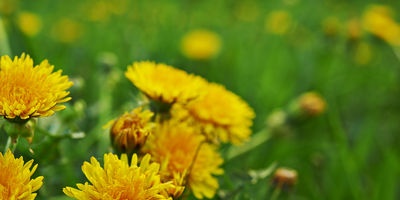|
 The world around us is rich and diverse. You just need to learn to understand him and use his gifts correctly. And for a sensitive, careful attitude, he will open in all his splendor, as did this unpretentious and graceful flower - the medicinal dandelion, which has settled almost throughout the country. The world around us is rich and diverse. You just need to learn to understand him and use his gifts correctly. And for a sensitive, careful attitude, he will open in all his splendor, as did this unpretentious and graceful flower - the medicinal dandelion, which has settled almost throughout the country.
From root to crown, he is ready to serve people - both at the patient's bedside and at a good feast.
Dandelion root has long been used in medical practice. They dig it up in the fall, and since the weather does not spoil at this time of the year, the collected rhizomes are dried in special dryers. Preparations from the roots of the flower have an exciting effect on the digestive organs, as well as choleretic and laxative properties. Therefore, in folk medicine, infusion of dandelion roots has long been used to stimulate appetite and improve the activity of the gastrointestinal tract, with some diseases of the liver and gallbladder.
But dandelion is not only a healer, it is also good for food. As soon as the soil warms up, its roots give tender tops. It is from it that you can prepare a delicious and very healthy salad. Young leaves are harvested and, to remove the characteristic bitterness, soak for 20-30 minutes in a strong salt solution. Draining the brine, squeeze the leaves slightly, chop finely, add sunflower oil to taste, mayonnaise, sour cream or lemon juice, can be crumbled garlic, egg. So the first spring salad is ready. No wonder in some countries dandelion is considered a full-fledged dining culture and is specially bred.
 But if dandelion salad is for everybody, then flower jam will undoubtedly appeal to many. The golden cap, so pleasing to the eye, is an inflorescence consisting of many small flowers. And each of them contains nectar. Little. But in general, the inflorescence is literally saturated with it. That is why bees and bumblebees love him so much. On an early sunny morning, while the dandelion is still full of fragrant and valuable nectar, the heads of the plant (without pedicels) are harvested. Then, about 200 flowers are dipped in 1 liter of water. It is impractical to take a larger number of flowers, since the remnants of greenery begin to give the jam a characteristic bitterness. After boiling over low heat for about an hour, the inflorescences are squeezed out and drained. Lemon without a peel is crumbled into the remaining syrup, 1 kg of sugar is added, after which it is boiled for another hour and a half to sample on the nail, like ordinary jam. Citric acid not only adds pungency, but also neutralizes the bitter taste of greens. In appearance, taste, smell, the resulting jam resembles young honey. This is quite understandable, since, in fact, we have prepared a nectar extract. But if dandelion salad is for everybody, then flower jam will undoubtedly appeal to many. The golden cap, so pleasing to the eye, is an inflorescence consisting of many small flowers. And each of them contains nectar. Little. But in general, the inflorescence is literally saturated with it. That is why bees and bumblebees love him so much. On an early sunny morning, while the dandelion is still full of fragrant and valuable nectar, the heads of the plant (without pedicels) are harvested. Then, about 200 flowers are dipped in 1 liter of water. It is impractical to take a larger number of flowers, since the remnants of greenery begin to give the jam a characteristic bitterness. After boiling over low heat for about an hour, the inflorescences are squeezed out and drained. Lemon without a peel is crumbled into the remaining syrup, 1 kg of sugar is added, after which it is boiled for another hour and a half to sample on the nail, like ordinary jam. Citric acid not only adds pungency, but also neutralizes the bitter taste of greens. In appearance, taste, smell, the resulting jam resembles young honey. This is quite understandable, since, in fact, we have prepared a nectar extract.
In general, the nutritional value of wild-growing flora is a big, separate topic. In the meantime, let us note that another mercilessly weed weed in terms of the content of nutrients, and even in taste, is able to give a hundred points ahead to many of its cultivated relatives ...
Here, it turns out, what a wonderful flower - an ordinary dandelion! Is he alone? Many of those plants that we expel from the site are ready to serve people with faith and truth. There are plenty of confirmations and examples of this.
... Tansy, a perennial herb with a strong, branched stem in the upper part, has turned yellow along the roadsides, among bushes, in floodplain meadows, on wastelands near dwellings. So the summer has begun to decline. Few people pay attention to this "savage". It is not particularly beautiful. It's even difficult to determine what it looks like. As if someone tied a dozen daisies with dangling petals, and so it turned out an inflorescence.
 But tansy is like a protection letter for the neighboring vegetation. Its smell is very unpleasant to various pests.Indeed, the active principle of the aroma of tansy is a complex mixture of essential oils, the main component of which is the toxic substance thujone, which belongs to the class of terpenes, which are very active compounds. Therefore, all kinds of evil spirits do not favor her: in the garden there are moths and other harmful insects, in the house - flies, moths, bugs, fleas ... Of course, in the garden there is a tansy weed. But transplant it in early autumn under fruit trees, and it will help you keep a good harvest and do without frequent spraying of the garden with pesticides. But tansy is like a protection letter for the neighboring vegetation. Its smell is very unpleasant to various pests.Indeed, the active principle of the aroma of tansy is a complex mixture of essential oils, the main component of which is the toxic substance thujone, which belongs to the class of terpenes, which are very active compounds. Therefore, all kinds of evil spirits do not favor her: in the garden there are moths and other harmful insects, in the house - flies, moths, bugs, fleas ... Of course, in the garden there is a tansy weed. But transplant it in early autumn under fruit trees, and it will help you keep a good harvest and do without frequent spraying of the garden with pesticides.
Or, say, wormwood, which once inspired melancholy on the disgraced poet Ovid ... It has a lot of useful qualities, including insecticidal properties. In addition to the previously considered compositions, we will also give one directed against caterpillars and moths. Up to half of the raw grass or 700-800 g of dried grass is placed in a bucket, poured with water, infused for 24 hours and boiled for 30 minutes, and before spraying, the solution is diluted in a ratio of 1 to 1.
In friendship, wormwood and our dandelion. Together they do a good job with aphids, apple moth, moth. Take 150 g of dandelion root and young tops of wormwood, pour 10 liters of water, hold for a day, filter - that's the protective drug is ready.
An infusion of leaves and baskets of chamomile inflorescences with the addition of a small amount of soap will save the garden from sucking insects and small caterpillars. As for the name of this plant, it speaks for itself and suggests some especially valuable properties of wild herbs that are especially useful to humans ...
Nikulin F.E.
|